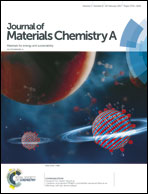An α-CrPO4-type NaV3(PO4)3 anode for sodium-ion batteries with excellent cycling stability and the exploration of sodium storage behavior†
Abstract
A novel α-CrPO4-type vanadium-based orthophosphate NaV3(PO4)3 was synthesized as a promising anode material for Na-ion batteries, which exhibits a high reversible capacity of 140 mA h g−1 with the capacity retention about 98% after 100 cycles. Furthermore, the electrochemical reaction mechanism, structure evolution and ionic diffusion of NaV3(PO4)3 during the sodiation process were surveyed by the combination of experiments and first-principles calculations. Two different Wyckoff sites (4b, Na2 and 4c, Na3) which can accommodate more sodium ions, as well as the corresponding Na insertion process were reported to understand the sodium storage mechanism in NaV3(PO4)3. The 3d-electron distribution near the Fermi level for vanadium in different valence states and sites (4a and 8g) in NaxV3(PO4)3 (x = 1, 2, 3) and the local electron transfer during the sodiation process were described to predict the transition of the electrochemical properties. The cooperative-transport mechanism dominates the Na diffusion in NaxV3(PO4)3 (1 ≤ x ≤ 3) and the activation barrier for Na+ transport in Na1.125V3(PO4)3 (0.30 eV) is much lower than that in NaV3(PO4)3 (1.28 eV), suggesting the fast-ion transport characteristics during the sodiation process and the strong stability of Na at the 4e site.



 Please wait while we load your content...
Please wait while we load your content...